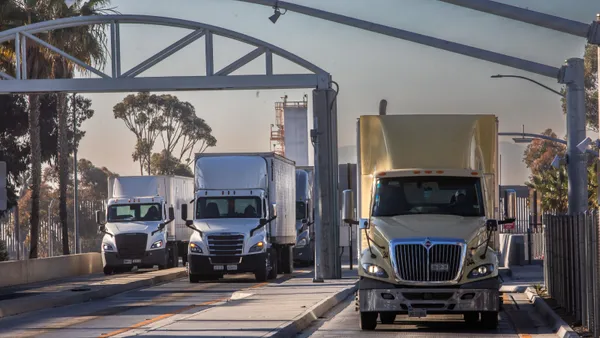Dive Brief:
- Another go round in the ongoing battle over the value of twin 33-foot trailers has begun, Logistics Management reported Monday.
- Fred Smith, CEO of FedEx, supports a measure that would allow for the installation of the trailers, while the Truckload Carriers of America (TCA) soundly dislike the plan, claiming it benefits only LTL carriers.
- The TCA also notes that railroad carriers have long ago set their own cars to the same 28- or 53-foot trailer size in order to ease transport standards from one mode to another, which the twin 33s would disrupt.
Dive Insight:
Those in favor of trucking's twin 33s are banking on President Trump's pro-business bent, and the fact that LTL freight will put less strain on America's struggling infrastructure.
This is an issue with a long history. In the 1980s and 90s, truckers were pressured into converting 45-foot trailers to 48-foot and 53-foot versions. The process was expensive and largely unrewarding, since shippers grabbed this extra space, called it "accepted" and left freight rates untouched. There's also the expense of training drivers to fit 66 feet into a 53 foot dock, as well as the need to break down the twinned 33s.
But, as it relates to supply chain management, the story is interesting because it provides an inside look into the reality of competing interests within the transportation industry, which could complicate a drive to overhaul the nation's infrastructure.
The internal battle highlights two key dynamics in how the logistics industry interacts with the government: First, Congress typically does not differentiate between modes of transportation upon allocation of funds; second, each sector's needs may not necessarily complement the other's.
Note how, according to Logistics Management, the actors pushing the switch to 33-foot trailers are FedEx, UPS and Amazon, or parcel and LTL carriers. Their arguments before the government revolve around the safety benefits given the better balance of such trailers, but truckload and rail carriers who oppose it claim it would force undue costs on intermodal transport for minimal gains.
Ports, rail and truck lobbies may have all united to push for a plan in general, but the battle for the share of the infrastructure funding pie and its related legislation is just beginning.














